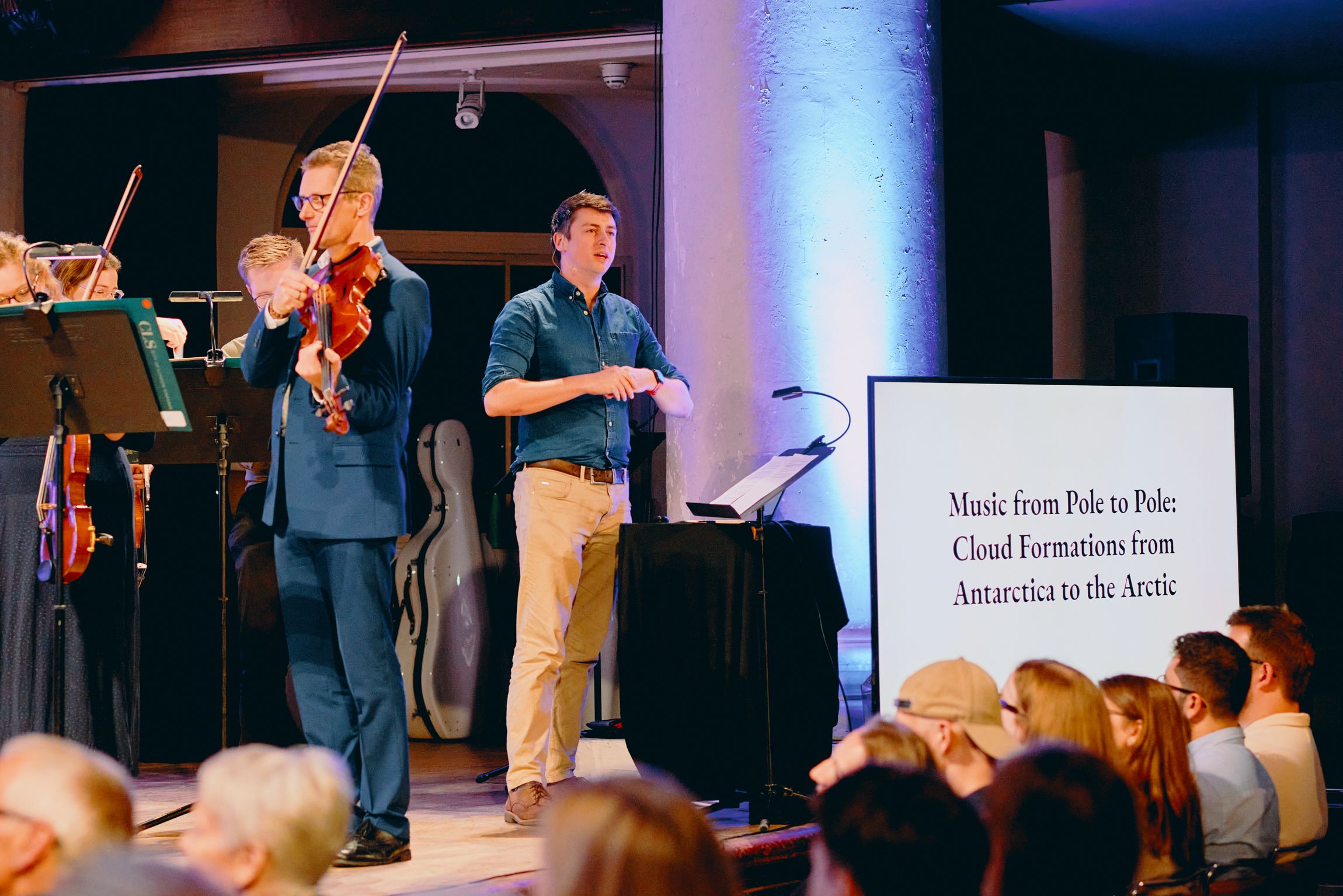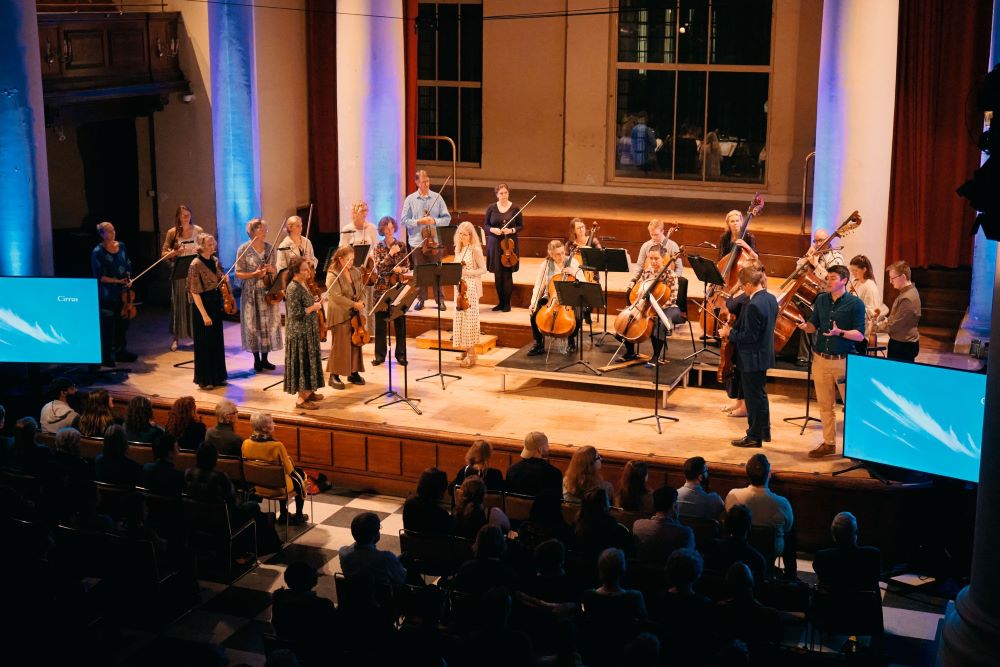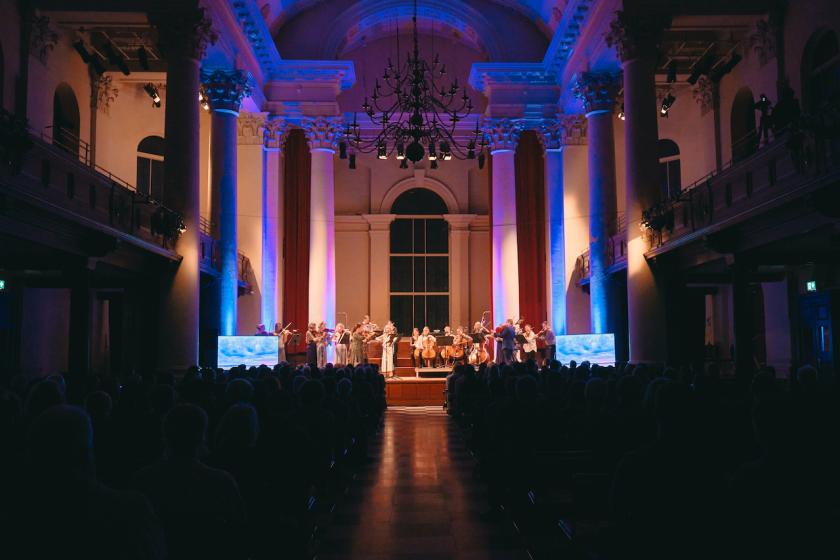It’s not often that a classical music concert offers to take you beyond the stratosphere and back, but this intriguing evening from the City of London Sinfonia did precisely that with considerable élan. All too frequently there’s a considerable gap between a fantastic idea and its satisfying execution, yet this musical trip from the Antarctic to the Arctic via different cloud formations proved to be as stimulating as it was passionately engaging.
That was due in no small part to the contribution of Dr Simon Clark (pictured below, far right), an atmospheric scientist who’s the author of a book on the subject – Firmament – as well as being something of a YouTube phenomenon. In a commentary that struck a nice line between being informative and poetic, he addressed those of us who didn’t know our nimbostratus clouds from our noctilucents, intelligently using the music to convey what’s so enthralling about suspended water droplets.
The evening began in darkness with a hauntingly powerful performance of Caroline Shaw’s In manus tuas, a 2009 work for solo cello based on a 16th century motet by Thomas Tallis. Joely Koos started by creating whispering effects with the bow that sounded like the wind reverberating round a creaky old ship before expanding into a frenzied bariolage sequence that sent ripples through the hushed church. A slower section ensued that more obviously mimicked a 16th century choir, before the playing became frenzied again. Darting harmonics heightened the sense that we were all being transported into a different dimension.  In his subsequent commentary, Dr Clark nicely set up the relationship between the concepts being explored and the music that was going to illustrate them. He explained that while In manus tuis was inspired by Tallis, it didn’t reflect his music so much as evoking the effect that the motet had on Shaw. In the same way, the evening’s very varied programme was not going to be some wispy – quite literally nebulous – attempt to create clouds in music. What we instead were going to experience was music that seemed to evoke the different – often surprisingly powerful – forces that shape clouds and by extension life on earth, along with Clark’s illuminating video projections.
In his subsequent commentary, Dr Clark nicely set up the relationship between the concepts being explored and the music that was going to illustrate them. He explained that while In manus tuis was inspired by Tallis, it didn’t reflect his music so much as evoking the effect that the motet had on Shaw. In the same way, the evening’s very varied programme was not going to be some wispy – quite literally nebulous – attempt to create clouds in music. What we instead were going to experience was music that seemed to evoke the different – often surprisingly powerful – forces that shape clouds and by extension life on earth, along with Clark’s illuminating video projections.
So it was that we were transported to the Antarctic with the help of three of Webern’s 5 movements for string orchestra, Op. 5, spiky spectral pieces that nicely suggested the ice crystals that form nacreous – or polar stratospheric – clouds. In the second movement, Webern’s stark, elliptical style – in which the echoes felt as important as the notes themselves – conveyed the austere terror of a frozen landscape, while the agitated third movement, through jagged pizzicatos and adrenalised crescendos, built a sense of existential dread. In the fourth, frost-tipped sound from the violins was underscored by a low resonant melody from the cello. Harmonics in the violins’ and violas’ upper registers gave a sense of the thinness of the air.
From the Antarctic we were swept out over the Southern Ocean, with Dr Clark inviting us to imagine ourselves in an airship floating to the north. The Southern Ocean can be notoriously turbulent, with crashing sea ice and powerful winds, yet we experienced it at its most calm from the perspective of stratocumulus clouds, benign flat formations that indicate weather change. Dvorák’s Nocturne in B, Op. 40 was our vehicle, and The City of London Sinfonia nicely conveyed the slow organic swirl of the music, with sweet overtones from the violins creating the shimmering silver lining to this particular species of cloud. As the music intensified, it felt we came closer to the waves of ocean itself, with interweaving melodies between violins and cellos giving a sense both of the water and the fish darting beneath its surface.
More oppressive nimbostratus clouds – dark grey formations that produce continuous rain or snow – took us to South America, and the Epilogue to Witold Lutosławski’s Musique funèbre immersed us in intense atonal melancholy. Moving further up the continent, Osvaldo Golijov’s fantastic diabolic Last Round – a tribute to Piazzolla – tipped its hat to the frequently thunderous arcus cloud as it swirled us up in a manic discordant tango. The sense of turbulence and compressed force was all-encompassing. With its aggressive upward glissandi and increasingly frenetic rhythms this really felt like a dance to the end of time.  A brief glitch – which reminded us that technology can be every bit as unpredictable as the weather – meant that the cloud video projections briefly disappeared, but Dr Clark quickly recovered the situation and we sailed on with aplomb. Musically now it was time for a full on tempest courtesy of that behemoth of clouds, the cumulonimbus. A breakneck performance of the Tempest movement from Marin Marais’ Alcione opera was dazzling in its strength and nimbleness. Violinist and director Alexandra Wood brilliantly led the ensemble, stamping her feet as the musicians truly seemed to summon the elements through the lightning swiftness of their execution.
A brief glitch – which reminded us that technology can be every bit as unpredictable as the weather – meant that the cloud video projections briefly disappeared, but Dr Clark quickly recovered the situation and we sailed on with aplomb. Musically now it was time for a full on tempest courtesy of that behemoth of clouds, the cumulonimbus. A breakneck performance of the Tempest movement from Marin Marais’ Alcione opera was dazzling in its strength and nimbleness. Violinist and director Alexandra Wood brilliantly led the ensemble, stamping her feet as the musicians truly seemed to summon the elements through the lightning swiftness of their execution.
After such a resolutely unclichéd line-up of pieces, when Vivaldi’s Summer arrived, we could properly experience the power and originality that defined it before it launched a thousand candlelit concerts. The heat-soaked languor of the start of the second movement soon evolved into more unsettled weather – as the presiding cloud, altocumulus castellanus suggested – while the third movement once more swept us up in a thrilling, exuberant storm.
By now the Arctic was beckoning, but first we had to stop off in the North Atlantic to experience the cirrus cloud. Here Thomas Adès’ O Albion, from his Arcadiana, provided a more contemplative moment to the evening. It felt like the auditory equivalent of lying in an English field watching wispy ice-crystal formed clouds passing overhead. This beautiful piece is a response to Elgar’s Nimrod, and the City of London Sinfonia evoked all the eloquence and yearning of the original.
Finally we reached the Arctic, where we were introduced to the exquisitely named noctilucent cloud, another ice-crystal formation, which is distinctive for being formed right up in the mesosphere. Anna Thorvaldsdottir’s unearthly translucent Spectra (movements 4,5, and 6) – performed by Alexandra Wood, Ian Rathbone and Joely Koos – felt just right for evoking this phenomenon, which can only be observed at the poles. Once the notes had faded away, the evening ended with the same three instrumentalists playing the Aria from Bach’s Goldberg Variations with a luminous delicacy that evoked its geometric perfection. On the screens, projections of the planets made it feel as if we were gliding through the universe, an appropriately elevated finish to an evening that was uplifting in every way.















Add comment